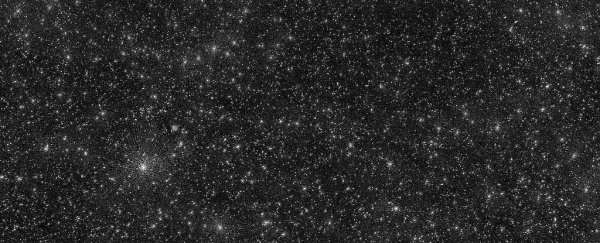Because we can't see black holes, it's hard to know exactly how many are out there in the big, wide Universe.
But that doesn't mean we have no means of trying to figure it out.
Stellar-mass black holes are the collapsed cores of dead massive stars, and new research incorporating how these stars and binaries form and evolve has been able to derive a new estimate of the stellar-mass black hole population of the Universe.
The number is pretty jaw-dropping: 40 quintillion, or 40,000,000,000,000,000,000 black holes, roughly making up 1 percent of all the normal matter in the observable Universe.
"The innovative character of this work is in the coupling of a detailed model of stellar and binary evolution with advanced recipes for star formation and metal enrichment in individual galaxies," explains astrophysicist Alex Sicilia of the International School of Advanced Studies (SISSA) in Italy.
"This is one of the first, and one of the most robust, ab initio computation[s] of the stellar black hole mass function across cosmic history."
Black holes are a huge question mark hanging over our understanding of the Universe – or rather, a lot of question marks. But if we have a good idea of how many black holes are out there, that could help answer some of those questions.
One approach is to estimate the history of massive stars in the Universe. We'd then be able to calculate the number of black holes that ought to be in any given volume of space.
This knowledge might yield clues as to the growth and evolution of supermassive black holes millions or billions of times the mass of the Sun, constituting the cores of galaxies.
Sicilia and his colleagues took a computational approach. They only included black holes that form via the evolution of single or binary stars, and taking into account the role of black hole mergers, whose numbers can be estimated based on gravitational wave data, and which produce black holes of slightly higher masses.
This allowed them to calculate the birthrate of stellar-mass black holes between five and 160 times the mass of the Sun over the lifespan of the Universe.
This birthrate suggests that there should be roughly 40 quintillion stellar-mass black holes scattered throughout the observable Universe today, with the most massive stellar-mass black holes produced by binary black hole mergers in clusters of stars.
The team compared their results against the gravitational wave data, and found that their estimate of the rate of black hole mergers was in good agreement with the observational data. This suggests that star cluster mergers are likely behind the black hole collisions we've seen.
By calculating the birthrate over time, the researchers were also able to derive an estimate for the number of stellar-mass black holes in the early Universe. This is of great interest, since observations of the distant Universe have revealed supermassive black holes at a shockingly early time after the Big Bang.
It's unclear how these behemoths grew so large so quickly. Some current questions concern the mass of the black hole 'seeds' from which they grew – whether they were light stellar-mass black holes or 'heavy' intermediate-mass black holes.
The team's research will provide a basis for investigating these questions. This paper was the first in a series; future papers will investigate intermediate-mass black holes and supermassive black holes for a more complete picture of the black hole distribution across the Universe.
"Our work provides a robust theory for the generation of light seeds for (super)massive black holes at high redshift, and can constitute a starting point to investigate the origin of 'heavy seeds', that we will pursue in a forthcoming paper," says astrophysicist Lumen Boco of SISSA.
The team's research has been published in The Astrophysical Journal.
